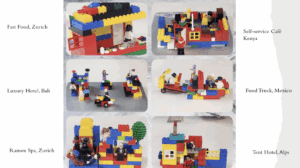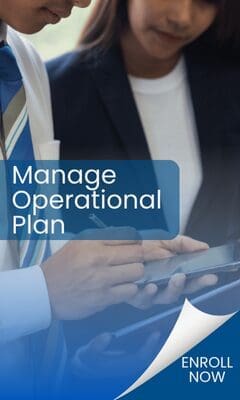Based on the above statement, LEGO® Serious Play® (LSP) is a facilitated thinking, communication, and problem-solving technique that uses LEGO bricks as a medium for creative expression and strategic dialogue. Originally developed in 2001 by LEGO Group executives Robert Rasmussen and Per Kristiansen, LSP was designed to foster innovation and collaboration within corporate environments.
What Is LEGO Serious Play?
At its core, LSP is building with Lego bricks on the idea that hands-on, minds-on learning can unlock deeper insights and foster more inclusive conversations. Participants can take this as a game which will help them to think out of the box and come with ideas and solutions that they have not thought with another method. The LSP methodology follows a structured process with a facilitator is guiding the participants as follows:
Build – Participants construct models using LEGO bricks in response to a facilitator’s question or statement. Many times the participants have a set number of bricks and need to be creative in order to achieve the goal.
Share – Each participant explains the meaning behind their model.
Reflect/Listen – The group listens without interruption, promoting equal participation and deeper understanding. This approach encourages metaphorical thinking, storytelling, and reflection, making it a powerful tool for ice-breaker, team building, strategy development, and personal insight.
Benefits of LEGO Serious Play
Inclusivity: LSP levels the playing field by giving everyone a voice, regardless of status or communication style.
Engagement: The tactile nature of LEGO bricks keeps participants actively involved.
Creativity: Encourages out-of-the-box thinking and metaphorical reasoning.
Reflection: Helps individuals access deeper insights and share personal narratives.
The Key Principles of LEGO Serious Play are as follows:
Everyone Participates, Everyone Contributes
LSP is designed to ensure 100% participation. Every participant builds and shares, which democratizes the conversation and taps into the collective intelligence of the group. This is also a great opportunity for ice breaker activities because everybody creates and talks.
Leaders Don’t Have All the Answers
The method assumes that valuable insights can come from any level of an organization. It encourages listening to all voices in the room, not just those in leadership roles. Participants will describe their models / ideas, thus an opportunity for brainstorming through building.
The Answer Is in the System
LSP views organizations as complex adaptive systems. The method helps uncover hidden knowledge and interconnections within the group, leading to more holistic solutions. The method can help participants find solutions by building individual models and then connecting it with a main idea.
Hands-On, Minds-On Learning
Building with LEGO bricks engages both the hands and the brain, activating different cognitive processes. This tactile engagement helps participants express ideas they might struggle to articulate verbally and come up with creative ideas, otherwise not possible to commence.
Metaphorical Thinking Enhances Understanding
Participants build models that represent abstract ideas metaphorically. This allows for deeper exploration of concepts and encourages creative and innovative problem-solving.
The Process Is the Product
The value of LSP lies not just in the models built, but in the stories told and the reflections shared. The process itself generates insights and fosters alignment. Many times the end result of the model can be a business idea.
Psychological Safety and Equal Voice
The structured format ensures that everyone has equal time to build and share, creating a safe space for open dialogue and reducing dominance by louder voices. All participants follow the steps as the facilitator leads them, which help them feel confident and allow them to be open in the group.
Reflection Is Integral
After building and sharing, participants reflect on what they’ve seen and heard. This step deepens understanding and helps integrate insights into actionable outcomes. This will also help people to open up in a group in case they are introverted.
How LSP can be used in Hospitality:
- Staff Training and Development
– Scenario Building: Employees can build models representing challenging guest interactions and explore solutions together.
– Empathy Training: Staff can create models that reflect guest experiences, helping them understand different perspectives.
– Team Bonding: LSP encourages open communication and trust, which is essential in high-pressure hospitality environments.
2. Service Design and Innovation
– Customer Journey Mapping: Teams can build the guest journey from check-in to check-out, identifying pain points and opportunities for improvement.
– New Service Prototyping: Use LSP to visualize and test new service concepts before implementation.
– Feedback Integration: Incorporate guest feedback into model-building sessions to co-create better experiences.
– New products and services can be designed as Lego models and then pitched to investors for funding in order to be actualized
3. Leadership and Strategy
– Vision and Values Alignment: Leaders and teams can build models that represent the organization’s mission and values, aligning everyone’s understanding.
– Strategic Planning: Use LSP to explore future scenarios, risks, and opportunities in a collaborative way.
– Change Management: Help teams visualize and emotionally process organizational changes.
4. Guest Experience Enhancement
– Role-Playing with Models: Simulate guest interactions to refine service delivery.
– Problem Solving: Address recurring guest complaints by modeling the service environment and brainstorming improvements.
5. Cross-Department Collaboration
– Breaking Silos: LSP sessions can bring together housekeeping, front desk, F&B, and management to co-create solutions. LSP sessions are excellent for ice breakers and introducing members to teams.
– Shared Understanding: Building models helps different departments understand each other’s challenges and contributions.
– Building Teams: LSP sessions can bring people together and work perfectly for team building.
Lastly, you can follow the links below to see how I utilize it in my modules, with respective posts on LinkedIn.

 Plato the famous Greek Philosopher once said:
Plato the famous Greek Philosopher once said:

























